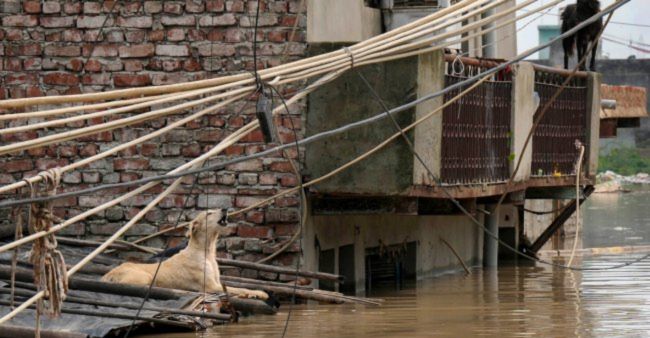17 animals died in this flood out of the 130 that had previously been rescued and nursed back to health.
The Intergovernmental Panel on Climate Change argues that a 1.5ºC warming will result in severe rain events which are unpredictable in duration, intensity, and occurrence. What we are experiencing this July—the wettest in almost 40 years—is a manifestation of this prediction. This year’s monsoon in North India has been further complicated by the El Nino phenomenon, linked with increased global temperatures.
According to climatologists at the Georgia Institute of Technology, the current year has also seen record land and sea temperatures. Hence, as the land surface temperatures in North India rise, heavy convectional rainfall is a natural outcome. This is unwelcome news for the barrages that control the flow of water and points to the forgone conclusion that if proper steps are not taken, Delhi will flood once again.
Earlier this month, North India witnessed extreme rainfall, leading to a sudden increase in water levels in the Hathnikund barrage and then the Yamuna river. On the morning of 13 July, the water level reached a staggering height of 208.48 meters (about 2.8 times the height of the Qutub Minar) at the Old Railway Bridge—a development described by the Central Water Commission as an “extreme situation”.
What happened subsequently is well known to all; for the first time in 45 years, Delhi experienced unprecedented flooding leading to the death of 22 people and countless animals. What most people do not know and cannot imagine is the challenges many civil society organisations faced in rescuing animals across the National Capital Territory (NCT). The heroic rescue of nearly 103 animals by the Purple Patch Trust is worth reporting and emulation.
Some experts also argue that the rising water level in the Yamuna was due to silt accumulation. Siltation or “sediment pollution” is a phenomenon in which rivers are choked due to sediment and plastic pollution which reach the rivers due to soil degradation, erosion, dredging and offshore dumping. In the case of the Yamuna, sediment pollution due to untreated waste water also produces another major problem. Delhi produces one billion gallons of waste water every day. The chokepoints produced due to the accumulation of organic and inorganic waste have resulted in the backwash of floodwater, resulting in stagnant water, producing further avenues for dengue and malaria.
The flooding situation was also due to poor management of storm drains that are simultaneously under the purview of many central, state, and local bodies and are impacted by the decisions of bodies in other states such as Haryana and Uttar Pradesh. Hence, the lack of a cohesive regulatory apparatus has caused policy paralysis and a futile blame game between political hopefuls.
Out of Delhi’s 24,840 hectares of flood plains, 68% are under the river Yamuna. The drainage morphology of Delhi is defined by the Aravalli foothills. Not every part of the NCT is on the same “altitude”. Substantial portions of areas near the Yamuna including Trans-Yamuna in east Delhi, Shahdara, Civil Lines and Old Delhi are low lying and face the risk of flooding if water-levels are not managed effectively. Areas around Kidawali, home to many animal shelters, gaushalas and dairy farms, lie close to the banks of the river and emerged as one of the worst affected areas when the river swelled. In one of the shelter areas standing water reached almost five feet. By the time animal rescue workers were allowed to reach the area, some smaller animals had drowned, and larger animals were trying to stay afloat. When volunteers reached on boats to rescue the stranded animals that had been standing in waist-deep water for more than 30 hours, they were met with elderly men and women hoping the rescue team was for them.
Many places in the NCT are “agrarian”. Although they are not “backward”, they are not well connected like Delhi. For example, residents of Kidawali and areas around did not receive adequate warnings pertaining to the barrage being relieved.
Working with the local administration also proved to be a challenge. In the case of the Purple Patch Trust, although the local authorities eventually offered help, the animals were clearly a second priority. This encouraged unwanted anti-social elements in the garb of “gau rakshaks” to harass the rescuers and owners. As the animals were being transported to safety the rescuers were stopped in the presence of the police and asked for papers for the cows in the middle of a flood. Even when the police asked them to step down, they forced the rescue team members and owners of the shelters to write a letter to the authorities for rescuing cows, even as some animals were showing signs of fatigue and were in a serious condition.
17 animals died in this flood out of the 130 that had previously been rescued, nurtured, and nursed back to health. Those who work to save animals recognise that for governments the utilitarian calculus is tilted towards anthropocentrism. However, it certainly raises a question: isn’t it the same attitude which got us here in the first place?
Abhilash Puljal is the founder of the Purple Patch Trust. He is also a Development Consultant and Strategy Advisor at Abhilash Puljal & Co. Research inputs by Mayank Chari.

